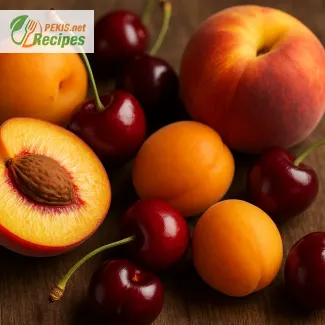
Ripe peaches, juicy cherries and fragrant apricots from late summer bring natural sweetness, acidity and aroma that enrich savory meals. Their balance of flavors complements proteins, grains and vegetables, turning simple dishes into layered culinary experiences. From grilled peaches with prosciutto to cherry reductions with duck or apricot glazes on chicken, these fruits add freshness and depth. Rooted in tradition yet thriving in modern cuisine, they combine nutrition and creativity, making them an essential part of seasonal cooking.
PEKIS – professional chef and recipe developer with more than 25 years of experience, specialized in European and international cuisine. For this creation, I draw on years of working with seasonal fruits in both traditional kitchens and modern dining, showing how late-summer peaches, cherries and apricots can turn everyday savory meals into something special.
The flavor power of late-summer stone fruits in savory cooking
From orchards to your plate: how peaches, cherries and apricots transform meals
Late summer brings an abundance of stone fruits – ripe peaches, juicy cherries and fragrant apricots. While most people immediately think of pies, jams or desserts, these fruits also hold immense potential for savory dishes. Their natural sweetness, vibrant acidity and aromatic depth can elevate everyday meals into something unexpected and memorable. By combining them with herbs, spices and proteins, you can create layers of flavor that balance freshness with richness.
A brief look at history and origin
Stone fruits have been cherished for thousands of years. Peaches originated in China more than 4,000 years ago and were prized as symbols of longevity. Cherries were cultivated by the Romans, who spread them across Europe. Apricots likely came from Central Asia, moving westward through trade routes. Historically, these fruits were used not only in sweet preparations but also in savory sauces, paired with roasted meats or preserved with spices for winter meals. Reviving this tradition today brings both cultural depth and culinary creativity.
The natural chemistry of peaches, cherries and apricots
The reason these fruits work so well in savory recipes lies in their chemical composition:
- Peaches provide juicy sweetness balanced by a subtle tartness.
- Cherries deliver concentrated flavors, ranging from sweet to slightly bitter, depending on the variety.
- Apricots are rich in aromatic compounds, offering tangy brightness that cuts through fatty or salty foods.
Together, they add complexity and help balance flavors in meat dishes, grain bowls or even salads.
Practical ideas with stone fruits in savory meals
- Pair grilled peaches with burrata, prosciutto or fresh basil.
- Add cherries to a wild rice salad with toasted nuts.
- Cook apricots into a glaze for chicken or duck.
- Combine roasted vegetables with slices of stone fruits for a vibrant side dish.
- Use chopped fruits in grain bowls to contrast earthy flavors like quinoa or farro.
Simple tricks for perfect results
- Choose ripe but firm fruit, so it holds its shape when cooked.
- Balance sweetness with acidic ingredients such as vinegar or citrus.
- Add texture with nuts, seeds or cheeses to create contrast.
- Roast or grill fruits to intensify natural flavors before adding them to dishes.
Culinary inspiration from traditional and modern kitchens
- In Middle Eastern cuisine, apricots are simmered with lamb and spices, creating savory-sweet stews.
- Italian cooking pairs peaches with cured meats and fresh mozzarella for light antipasti.
- In contemporary gastronomy, chefs experiment with cherry reductions to accompany duck, venison or pork.
- Modern plant-based kitchens use roasted stone fruits in grain salads, lending natural sweetness without added sugar.
Flavor pairings and combinations to try
- Herbs: rosemary, thyme, basil, mint.
- Proteins: chicken, duck, pork, goat cheese.
- Grains: quinoa, farro, couscous.
- Condiments: balsamic vinegar, soy sauce, chili flakes.
These combinations enhance the natural character of fruits while grounding them in hearty savory contexts.
Benefits beyond taste
Stone fruits do more than delight the palate. They are rich in vitamins A and C, antioxidants and dietary fiber. Adding them to savory meals not only enhances flavor but also supports overall wellness, making them a valuable part of late-summer dining.
Inspiration for your next meal
Whether tossed in a salad, roasted with root vegetables, or turned into a sauce for grilled meats, late-summer peaches, cherries and apricots provide endless opportunities. Their role in savory cooking reflects both history and innovation, bridging old traditions with new culinary ideas.
By experimenting with these fruits in everyday meals, you’ll discover how easily they can elevate savory dishes, making your table more colorful, nutritious and full of character.
FAQ questionCan peaches really be used in savory dishes?
Yes, their natural sweetness and slight acidity balance salty or rich flavors, making them perfect for pairing with meats, cheeses and roasted vegetables.
FAQ questionWhat proteins work best with cherries?
Cherries pair beautifully with duck, pork and venison, as their tart-sweet profile cuts through richness and adds depth.
FAQ questionAre apricots better fresh or cooked in savory meals?
Both work well. Fresh apricots add brightness to salads, while cooked apricots create flavorful glazes or stews with chicken and lamb.
FAQ questionHow do I keep stone fruits from becoming too soft when cooked?
Choose ripe but firm fruit and avoid overcooking. Grilling or quick roasting helps maintain texture while enhancing flavor.
FAQ questionWhat herbs and spices complement stone fruits in savory recipes?
Herbs like rosemary, thyme and basil highlight fruity notes, while chili flakes, cumin and black pepper bring contrast and depth.
FAQ questionCan stone fruits add nutritional value to savory dishes?
Yes, they provide vitamins A and C, antioxidants and dietary fiber, enriching meals with both flavor and nutrition.